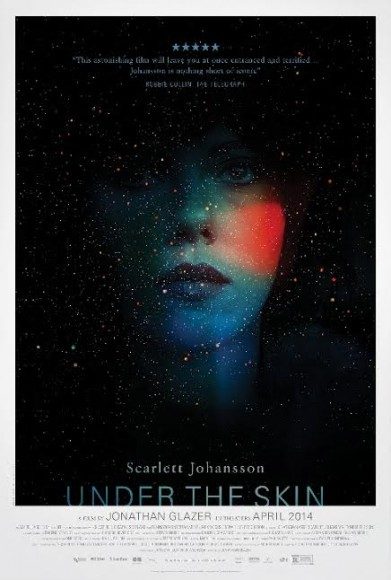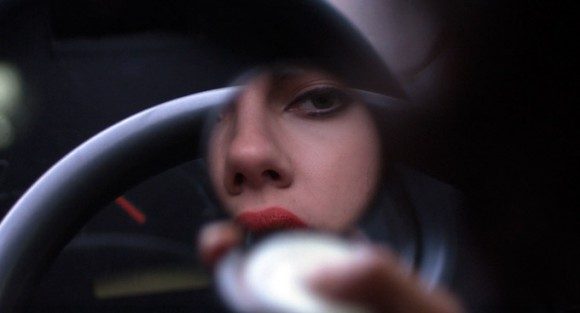

Under the Skin might be best described as existing in the same world as Men in Black. It has sci-fi elements, including an introduction to the main character that can hardly be seen as anything but a Terminator homage, but predominantly exists in a world more mundane and humorless than either of the above franchises. Director Jonathan Glazer clearly has a vision for what he’s doing; there’s a stylistic unity to the picture that’s among its best qualities. Style alone will only get you so far, though, and despite a persistent sense that Glazer believes he’s onto something big, for me, Under the Skin reduces to superficiality a little too easily.
The story follows Scarlett Johansson as an unnamed woman (though it’s immediately suggested she doesn’t fit a truly human description, suspicions which are not long in being confirmed) who drives about Scotland enticing unattached men with suggestions of sex. This seems to be important somehow, and she is not alone on her mission to bring these men, nigh hypnotized, back to any number of prepared hideouts.
From this point I’m going to assume that if you’re reading this review that you don’t mind being spoiled on a couple of plot points, because this movie is going to be rather difficult to talk about otherwise. I won’t give away any of the ending, but if you want condensed and spoiler-free thoughts, jump on down to The Verdict.
So yes, the Scarlett Johansson character is an alien of some sort, and the men she lures into her dens to kill them for reasons never made more clear than, “Because aliens.” This is gone about quite dispassionately at first, though after the Woman (as I guess we’ll call her) witnesses some selfless human bravery and a crying child, the emotionally empty alien begins to develop feelings. This becomes the narrative thrust of roughly the second half of the film, as she re-examines her previously unquestioned homicidal purpose.
Before getting into that a little bit more, we do need to discuss the style in which this movie is made. As I said at the top, there is a stylistic integrity to the film that runs from the color palette (high contrast of light and dark, which simultaneously highlights white and black while making colors pop without being oversaturated) to the cinematography (with a preference for long, lingering shots) to the score (alternatively malevolent in mood and malevolent towards the listeners eardrums, through for the most part purposefully so). Especially given the fairly straightforward narrative, this is actually where the meat of the film is found. Glazer is shooting for high art here, with lots of visual and auditory flourish. It’s not an understatement to say there are at least three shots of Johansson’s expressionless face over the course of the film which last at least 15 seconds each, the longest of which is probably a solid 25 seconds.
The trouble is that in all that artifice, I found very little art. All the elements above constantly suggest there is something more at play in the plot – something “under the skin” which the audience should be picking up on, some underlying message communicated through the combination of narrative and aesthetics. Leaving open the possibility that I just missed something – I don’t think so, but this is, after all, one man’s opinion – that’s a problem because the movie is very easily reduced to a couple of easily stated ideas. One, this is another film about an alien/robot/choose-your-emotionless-humanoid stand-in learning what it means to be human. Two, men are pigs who use women. The issue in both cases isn’t that these are things which aren’t worthy to be discussed; rather, it’s that the film offers no discussion.
Let’s hit the first one first. The reason humanoid stand-ins have become an archetype is that they allow us to explore the complexities of humanity with the mind of an adult and the eyes of a child. You only have to go back as far as Johansson’s last role to see it done really well. Samantha, the operating system in Her that Johansson voiced, begins the movie lacking in any knowledge about how to interact with people, yet she’s key to the movie developing ideas about how humans can and ought to interact with one another. She helps both Theodore (Joaquin Phoenix) and the audience see their own humanity in a new and challenging light
In Under the Skin, the same idea is present, but on a purely superficial level. The Woman adds to her emotional repertoire by minor degrees over the course of the film, but there’s never a comment on what it means to be human other than the most vague suggestions, and what little there is takes place over such an agonizingly long period of the film that it doesn’t have much effect.
On to the second idea, that men are pigs. This is a thematic idea that is inescapable, but again, never developed beyond the initial conception. Throughout the film, the Woman is seen as a sexual object. At first it’s by design, to lure unwitting Don Juans to their doom, but even when there are hints of deeper connection the film returns to the idea of sexual usefulness. The movie doesn’t suggest why this has become a part of our culture; neither does it suggest a way out. It merely reiterates that it is part of our conception of women. We simply don’t need 108 minutes of fancy fluff to make this single point.
The Verdict: 2 out of 5
It’s admirable that Jonathan Glazer had such high aspirations for this movie. It’s impossible to shake the notion that he believes he’s captured something deeply meaningful in Under the Skin. If he sees it, more power to him. I don’t. I have respect for the skill that goes into crafting a movie that functions on the level that Under the Skin shoots for, but the complete package is not here. There is simply not much of anything under the skin of some pretty artifice.



